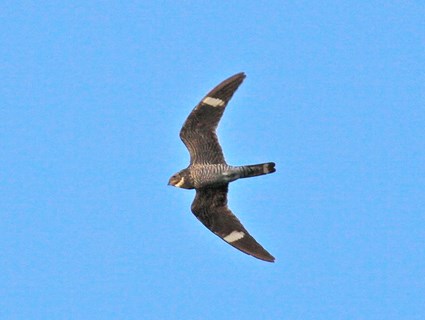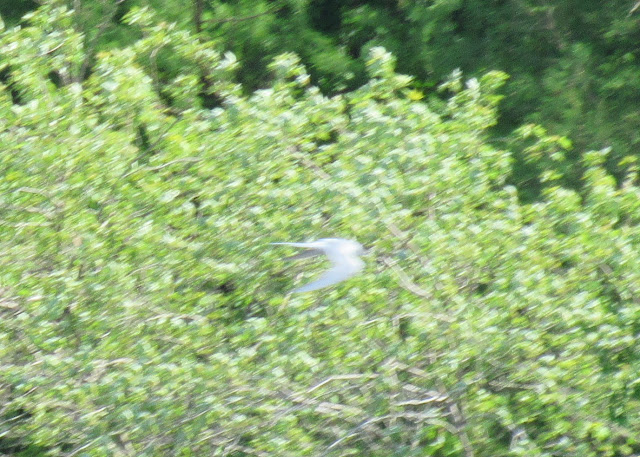Today was one of the finer days of my life. Classes are over, I'm off to the Smokies in a week and I'll be exploring Mason County sand areas and Nipper Wildlife Sanctuary (again) between now and then. The weather is fine, and so are the animals. I feel as if I'm neglecting the plant life a lot more this year, but to be fair, birds are a new field for me, and I live in an area of the world with excellent birding opportunities. Among which includes the Baltimore Oriole (Icterus galbula) below, spotted a few days ago in the vicinity of my workplace and deemed not worthy of its own post:
I decided to visit Marina Point today. The reason for this was that a few days ago, I saw three Forster's Terns (Sterna forsteri), two of which sat on nearby buoys near enough for a photo. Assuming conditions hadn't changed much, despite at least one storm system and two day's time, I returned. Here's my most successful shot of the lone Forster's Tern I did manage to find:
You can see the white wings and long tail, at least. Ordinarily, I wouldn't upload such a terrible picture, but Forster's Tern is a State-Endangered species in Illinois, mostly because it breeds up near Lake Michigan, in nature preserves just north of Chicago. The majority of the Forster's Terns in this area breed further north, up in Wisconsin and Michigan. Here's a better picture, cribbed from the Internet, and more specifically Howard Eskin's photo for the New Jersey Audubon Society:
These bird are incredibly skilled in the air. Some birds, like robins, seem to disdain flying, moving only a short distance before coming back to the ground. Other birds, like sparrows, just seem to do it as a matter of life. Terns, however, in their fluid and graceful motions, seem to actively enjoy flying.
A second tern was present as well, a much larger bird with a much shorter tail. This is a bird I have never seen before, the Caspian Tern (Hydroprogne caspia). By larger, I mean just a bit bigger than a Ring-billed Gull. Forster's Terns are half the size of Caspian Terns, but both are acrobats in the air. As I was taking pictures of the Forster's Tern, I noticed this creature among the rocks:

This is a Northern Watersnake (Nerodia sipedon sipedon) , and as I walked along, I suddenly scared two more into the water, in a fifteen foot stretch of rock. Clearly, this warranted investigation. I pulled out my nets from the car to try and catch one of these snakes for closer examination. One of the local population of fishermen in the area asked me what I was after, and I told him. He told me that a couple of days ago, the snakes had arrived en masse on Marina Point, and that he's seen several within the last couple hours of fishing. Needless to say, I stopped looking for terns,
I believe this is a Graham's Crayfish Snake (Regina grahamii), a species not particularly common in Illinois but fairly common on Lake Springfield. I saw at least three.
I'm going to assume the snake pictured above is a Midland Water Snake (Nerodia siphedon pleralis), because it kinda looks like the Wikipedia photo.
The snake above was quite beautiful, and likely in genus Nerodia, but I do not know the species. The bands were dark red and faded. ( Doesn't that picture look familiar...Yes, I know it's the one at top.)
Another Northern Water Snake, one of at least seven I saw, probably more, because I lost track of how many snakes there were, after a bit, I know that there were at least a dozen, which was good enough for me. I still don't know why so many snakes suddenly appeared. I left out pictures of snakes for this post, which I almost never do. My camera also decided to run out of batteries in the middle of this process, and I accidentally grabbed the already-drained spare, so I didn't photograph at least a third of the snakes.
This Graham's Crayfish Snake was just sticking out of a rock, so I caught it by the neck and pulled it out. Looking at the eye, it may have recently shed, so I somewhat regret doing this. Apparently, the principal method of defense for a Graham's Crayfish Snake is wrapping around whatever's grabbing it and urinating/defacating. Also, their poop is bright orange and reeks, probably because it's digested crayfish. Needless to say, I got him in the net as soon as I could.
The identifying marks of a Graham's Crayfish Snake is the underbelly, which is either plain or has a line of dark spots under it. I have yet to see the spotted-bellied individuals of this species.
I have no idea what species this is, above, but it was a bit more vibrant than the picture lets on.
This three and a half foot long snake was more exposed than most, and I soon caught it.
This is the the largest snake I've ever caught. Several fishermen gathered to look at it, and I had one of them hold the nets while I took pictures. I have no idea what species this is.
Here is the same snake upon release. It doesn't look as large as it actually is, in this photo. After about an hour of this snake stuff, I had other things to do. I ran off to the Beach House, where an abandoned recreational beach affords sandpipers some habitat on an otherwise rocky lakeshore:
The Spotted Sandpiper (Actitis macularius), seen above, is by far the most common species, and this is also my first true sandpiper. I discount the Timberdoodle, as that may be related, but it lives such a different lifestyle that it almost seems discriminatory to lump it together with these shorebirds.
Here, you can see the spots that this bird is named for. Spotted Sandpipers are probably the only breeding sandpiper species on Lake Springfield. I have never seen them until very recently.
Also, Spotted Sandpipers are a bit... small?... especially compared to a Mallard (Anas platyrhynchos).
On the way back from the sandpipers, I spotted a couple of Baltimore Orioles. At that point, I just said, "Thank you, God," and went to dinner. (By popular request) I spotted some wild students (Homo sapiens) enjoying this dinner, which I partook in:
(Sorry if the picture turned out badly, but you asked me to post it on my blog, #blamewill)
After dropping one of these creatures off at its den, I was driving back around dusk when I spotted a number of shapes flying over a nearby highway-side grassland, and I... kept driving, because it was the interstate. However, eBird (© Bruno P., Great Meadows NWR, Massachusetts, August 2009) has me covered for the Common Nighthawk (Chordeiles minor) , a species I have never seen before:

To recap: Four bird species I have never seen before in my life, more snakes than I've ever seen in one wild area in my life, a fine dinner with friends, and several of one of my favorite birds, Baltimore Orioles. The really funny part is that I wanted to go off and go hiking on this very same day, and visit a state park for one of my expeditions. That did not work out at all, but God has a very good sense of humor. By not doing what I planned, I had more fun anyway. Does that make sense to you? If it does, let me know. Also, let me know what those unidentified snakes were, please. Anyway, this has been a stellar year, and I cannot wait to explore, in order... Mason County Sand Areas, Nipper Wildlife Sanctuary, and the Smoky Mountains! Have a good night!

















If you don't mind me asking, what part of Lake Springfield specifically were the Graham's Crayfish Snakes found?
ReplyDeleteThis comment has been removed by the author.
DeleteThank you, now I can attempt to find a wild one.
Delete